Multiaxial Fatigue Damage Analysis of Steel–Concrete Composite Beam Based on the Smith–Watson–Topper Parameter
Abstract
:1. Introduction
2. Experimental Program
2.1. Test Specimen Geometry and Material Properties
2.2. Load Bearing-Capacity Calculation
2.3. Loading and Measurement Setup
3. Test Results and Analysis
3.1. Failure Process
3.2. Load–Deflection Curve
3.3. Load–Section Strain Relationship
3.4. Relative Slip
4. Finite Element Analysis
4.1. Establishment of the Finite Element Model
4.2. Constitutive Relation
4.3. Finite Element Results Analysis
4.4. Stress Analysis
5. Fatigue Damage Parameter Analysis
5.1. Critical Damage Plane Method
5.2. Parameter Analysis
6. Conclusions
- (1)
- The fatigue failure process of the steel–concrete composite beams begins with plastic deformation occurring in the welded joints, followed by the concrete slab undergoing hundreds of thousands of fatigue load cycles until the concrete strength reaches its limit and starts to spall until failure.
- (2)
- By integrating experimental data and a nonlinear material constitutive defined by formulas, key positions within the finite element model can be finely modeled, effectively simulating the load–slip curve and stress–strain values of the steel–concrete composite beams. Additionally, the use of finite element simulation provides a more intuitive understanding of those disadvantageous positions that are typically difficult to observe experimentally.
- (3)
- The finite element analysis shows that the shear transfer between components and the welded parts in the shear zone are in a multiaxial stress state, where longitudinal normal stress, vertical normal stress, and shear stress coexist. Observations and calculations of fatigue damage parameters at the most disadvantageous load positions are essentially consistent; thus, using the critical plane method based on SWT parameters to evaluate and predict the fatigue locations of components is reliable.
- (4)
- Fatigue damage parameters indicate that the most disadvantageous loading plane of the experimental beam is in the shear zone, and the stud weld toes, which experience the highest tensile stress, are more susceptible to fatigue cracking compared to the contact surfaces. Setting initial porosity defects, the performance impact caused by them is offset by the various components of the composite beam, with the growth in damage parameters being less than the strength reduction rate. The variation in component porosity has a more significant impact on the overall damage parameters than the pore size, which requires more attention in engineering applications.
Author Contributions
Funding
Data Availability Statement
Conflicts of Interest
References
- Wang, D.; Tan, B.; Zhao, P. Experimental and numerical study of temperature gradient effect on behavior of steel-concrete composite bridge deck. J. Build. Struct. 2021, 42, 74–82. [Google Scholar]
- Zou, Y.; Jiang, J.; Yang, J.; Zhang, Z.; Guo, J. Enhancing the toughness of bonding interface in steel-UHPC composite structure through fiber bridging. Cem. Concr. Compos. 2023, 137, 104947. [Google Scholar] [CrossRef]
- Cao, X.; Cheng, C.; Wang, M.; Zhong, W.; Kong, Z.; Chen, Z. Experimental study on the flexural behavior of flat steel-concrete composite beam. Can. J. Civ. Eng. 2020, 48, 1155–1168. [Google Scholar] [CrossRef]
- Zeng, Y.; Yu, T.; Xiao, Y.; Li, W. Investigation of the Mechanical Features of Steel–Concrete Composite Girder Rigid Frame Bridges with V-Shaped Piers during Construction Stages. Appl. Sci. 2024, 14, 3343. [Google Scholar] [CrossRef]
- Silva, M.L.d.; Prado, L.P.; Félix, E.F.; Sousa, A.M.D.d.; Aquino, D.P. The Influence of Materials on the Mechanical Properties of Ultra-High-Performance Concrete (UHPC), A Literature Review. Materials 2024, 17, 1801. [Google Scholar] [CrossRef] [PubMed]
- Wang, D.; Zheng, Z.; Xu, Z.; Yan, W.; Zhang, B. Study on the effect of length of bolted connectors on shear bearing capacity in steel-mixed composite structures. Highw. Mot. Transp. 2022, 4, 97–100+105. [Google Scholar]
- Wu, Y.; Wang, X.; Fan, Y.; Shi, J.; Luo, C.; Wang, X. A Study on the Ultimate Span of a Concrete-Filled Steel Tube Arch Bridge. Buildings 2024, 14, 896. [Google Scholar] [CrossRef]
- Burhan, I.; Kim, H.S. S-N Curve Models for Composite Materials Characterisation, An Evaluative Review. J. Compos. Sci. 2018, 2, 38. [Google Scholar] [CrossRef]
- Motte, R.; De Waele, W. An Overview of Estimations for the High-Cycle Fatigue Strength of Conventionally Manufactured Steels Based on Other Mechanical Properties. Metals 2024, 14, 85. [Google Scholar] [CrossRef]
- Wang, D.; Tan, B.; Xiang, S.; Wang, X. Fatigue crack propagation and life analysis of stud connectors in steel-concrete composite structures. Sustainability 2022, 14, 7253. [Google Scholar] [CrossRef]
- Xiang, D.; Gu, M.; Zou, X.; Liu, Y. Fatigue behavior and failure mechanism of steel-concrete composite deck slabs with perforated ribs. Eng. Struct. 2022, 250, 113410. [Google Scholar] [CrossRef]
- Łagoda, T.; Vantadori, S.; Głowacka, K.; Kurek, M.; Kluger, K. Using the Smith-Watson-Topper Parameter and Its Modifications to Calculate the Fatigue Life of Metals, The State-of-the-Art. Materials 2022, 15, 3481. [Google Scholar] [CrossRef] [PubMed]
- Li, X.; Yang, H.; Yang, J. Fretting Fatigue Life Prediction for Aluminum Alloy Based on Particle-Swarm-Optimized Back Propagation Neural Network. Metals 2024, 14, 381. [Google Scholar] [CrossRef]
- Branco, R.; Costa, J.D.; Prates, P.A.; Berto, F.; Pereira, C.; Mateus, A. Load sequence effects and cyclic deformation behaviour of 7075-T651 aluminium alloy. Int. J. Fatigue 2022, 155, 106593. [Google Scholar] [CrossRef]
- Wang, B.; Huang, Q.; Liu, X. Comparison of static and fatigue behaviors between stud and perfobond shear connectors. KSCE J. Civ. Eng. 2019, 23, 217–227. [Google Scholar] [CrossRef]
- Xing, Y.; Han, Q.; Xu, J.; Guo, Q.; Wang, Y. Experimental and numerical study on static behavior of elastic concrete-steel composite beams. J. Constr. Steel Res. 2016, 123, 79–92. [Google Scholar] [CrossRef]
- GB 50010-2010; Code of Design Concrete Structures. China Construction Industry Press: Beijing, China, 2011; pp. 209–211.
- Wang, B.; Liu, X.; Zhu, P. Residual bearing capacity of steel-concrete composite beams under fatigue loading. Struct. Eng. Mech. 2021, 77, 559–569. [Google Scholar]
- Arora, P.; Gupta, S.K.; Samal, M.K.; Chattopadhyay, J. Validating generality of recently developed critical plane model for fatigue life assessments using multiaxial test database on seventeen different materials. Fatigue Fract. Eng. Mater. Struct. 2020, 43, 1327–1352. [Google Scholar] [CrossRef]
- Wu, Z.; Hu, X.; Song, Y. Multiaxial fatigue life prediction for titanium alloy TC4 under proportional and nonproportional loading. Int. J. Fatigue 2014, 59, 170–175. [Google Scholar] [CrossRef]
- Smith, K.N.; Watson, P.; Topper, T.H. A stress–strain functions for the fatigue of metals. J. Mater. 1970, 5, 767–778. [Google Scholar]
- Kujawski, D. A deviatoric version of the SWT parameter. Int. J. Fatigue 2014, 67, 95–102. [Google Scholar] [CrossRef]
- Vicente, M.A.; González, D.C.; Mínguez, J.; Tarifa, M.; Ruiz, G.; Hindi, R. Influence of the pore morphology of high strength concrete on its fatigue life. Int. J. Fatigue 2018, 112, 106–116. [Google Scholar] [CrossRef]
- Chandrappa, A.K.; Biligiri, K.P. Effect of pore structure on fatigue of pervious concrete. Road Mater. Pavement Des. 2019, 20, 1525–1547. [Google Scholar] [CrossRef]
- Cui, W.; Liu, M.; Song, H.; Guan, W.; Yan, H. Influence of initial defects on deformation and failure of concrete under uniaxial compression. Eng. Fract. Mech. 2020, 234, 107106. [Google Scholar] [CrossRef]
- Lv, C.; Wang, K.; Zhao, X.; Wang, F. Damage-Accumulation-Induced Crack Propagation and Fatigue Life Analysis of a Porous LY12 Aluminum Alloy Plate. Materials 2024, 17, 192. [Google Scholar] [CrossRef]


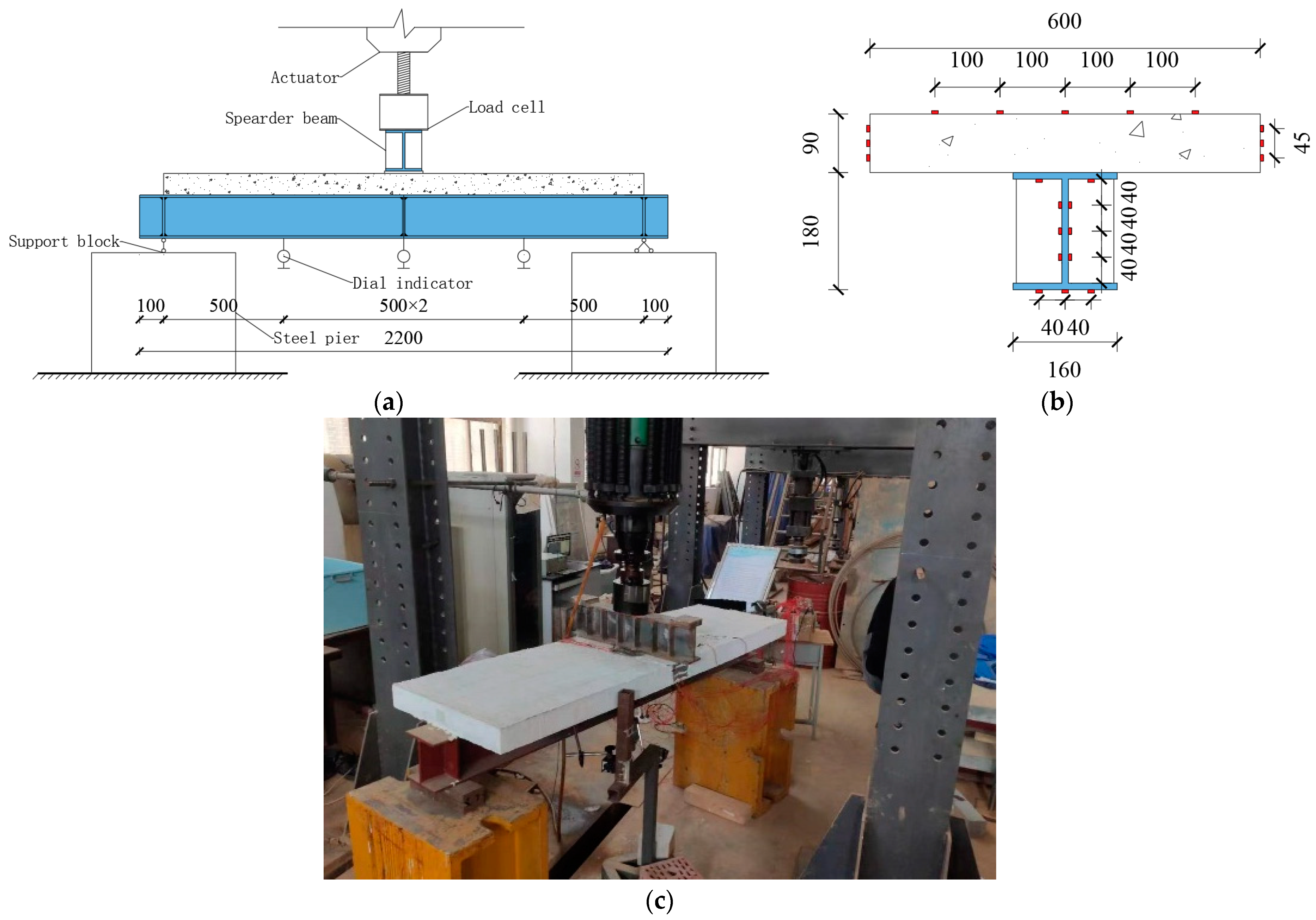
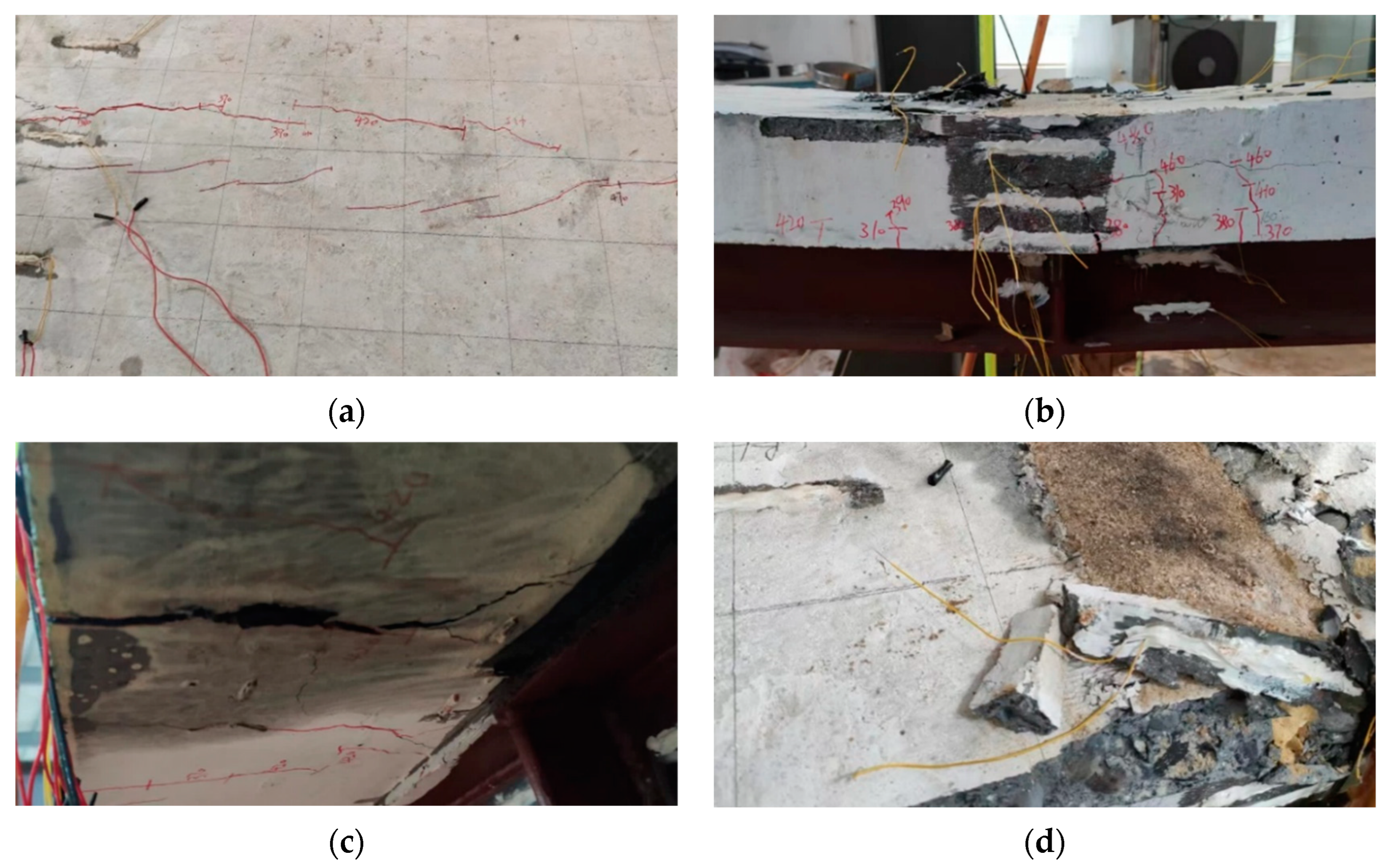
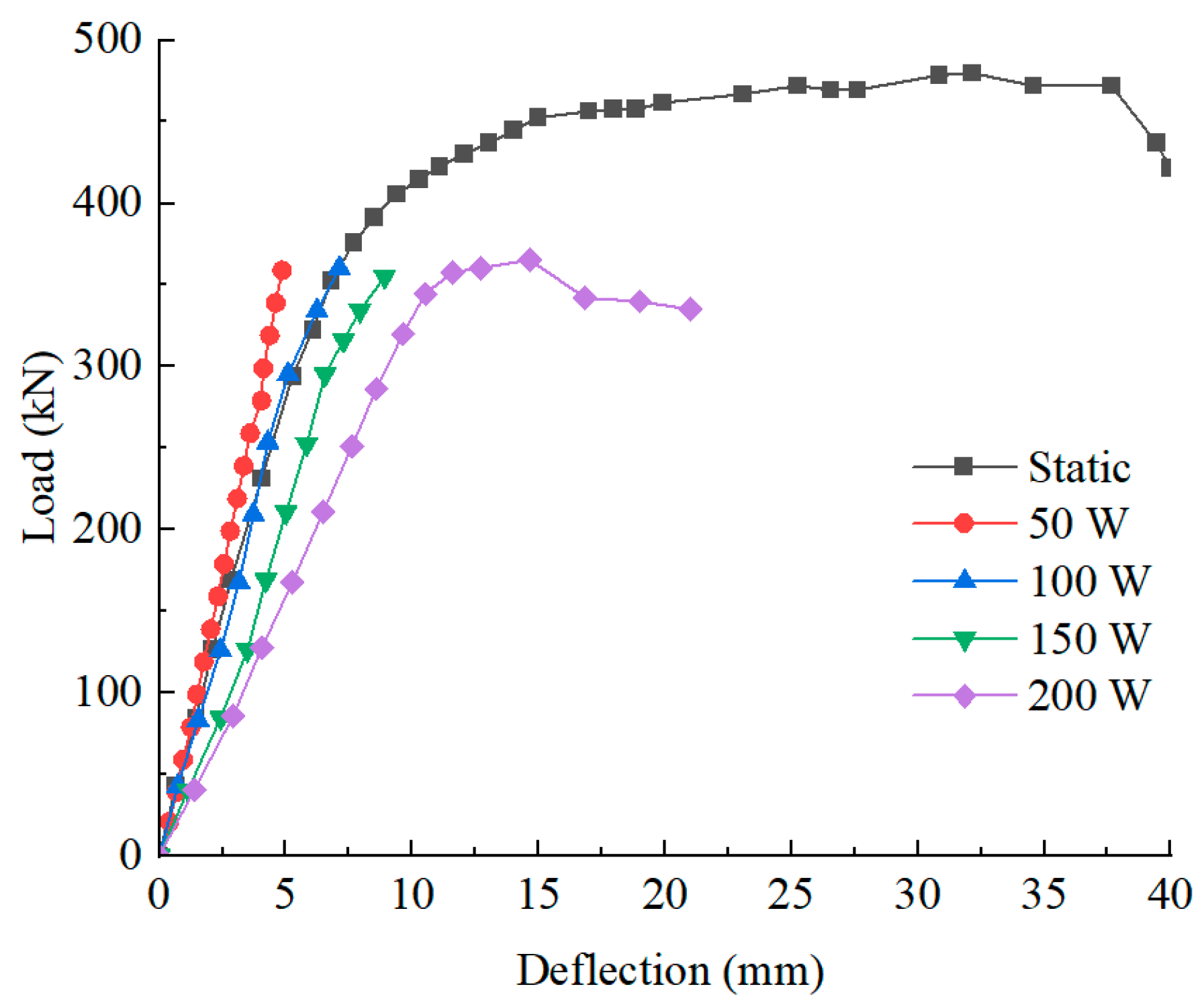
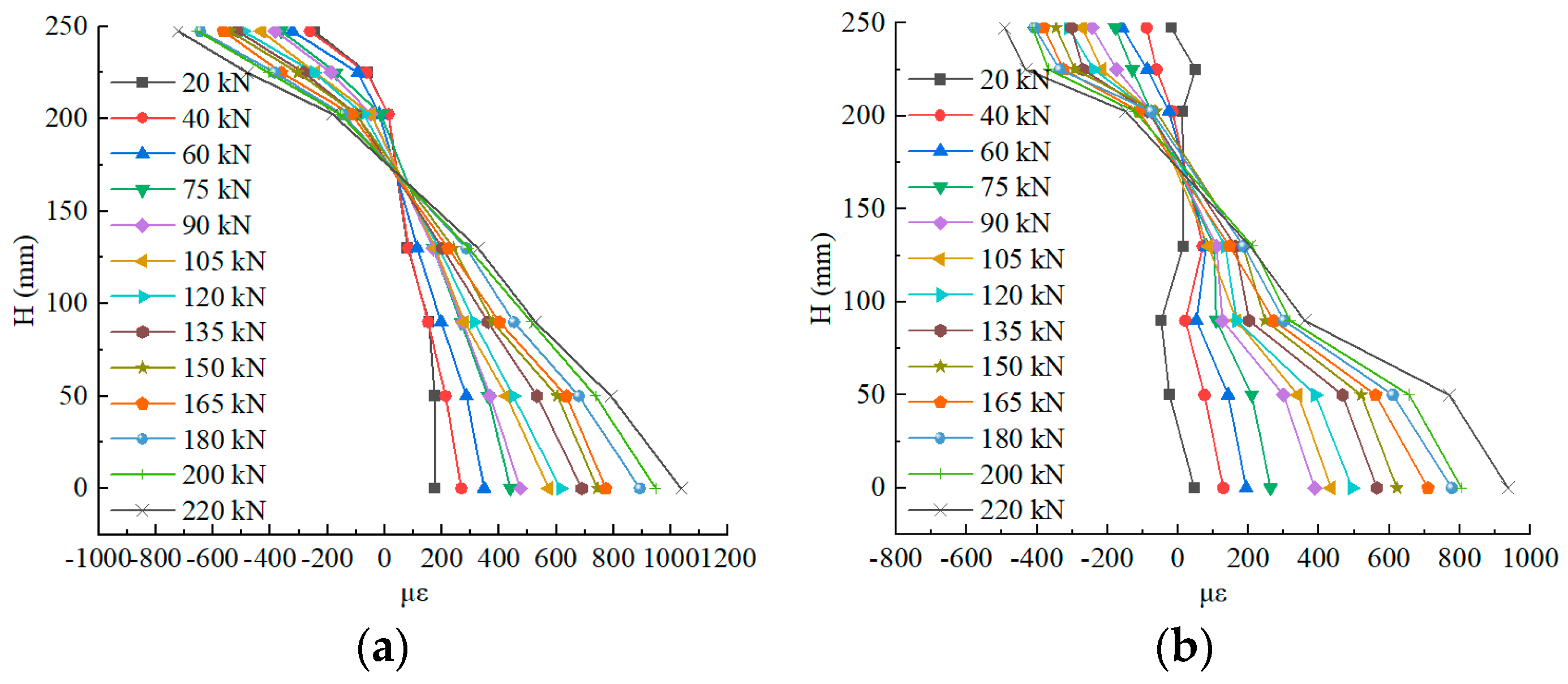
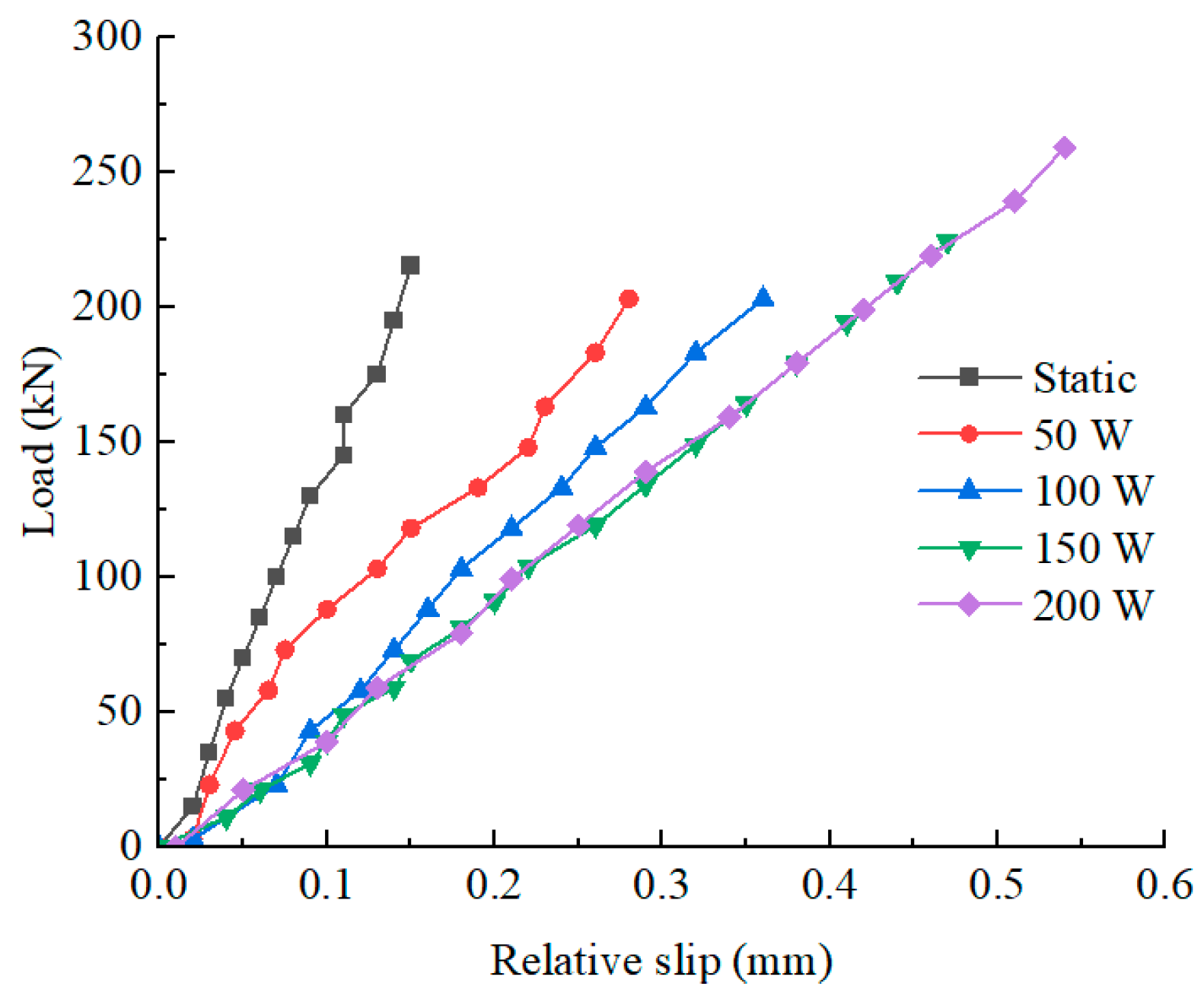
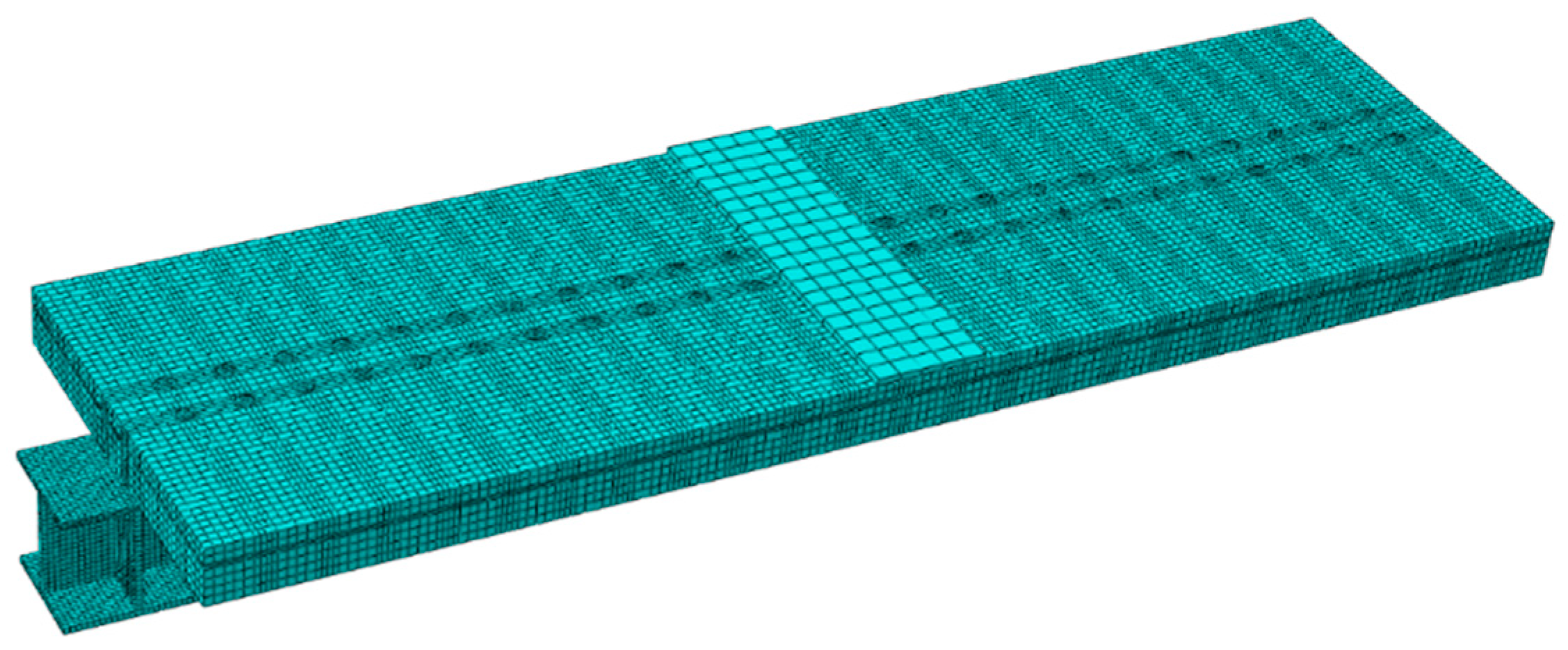
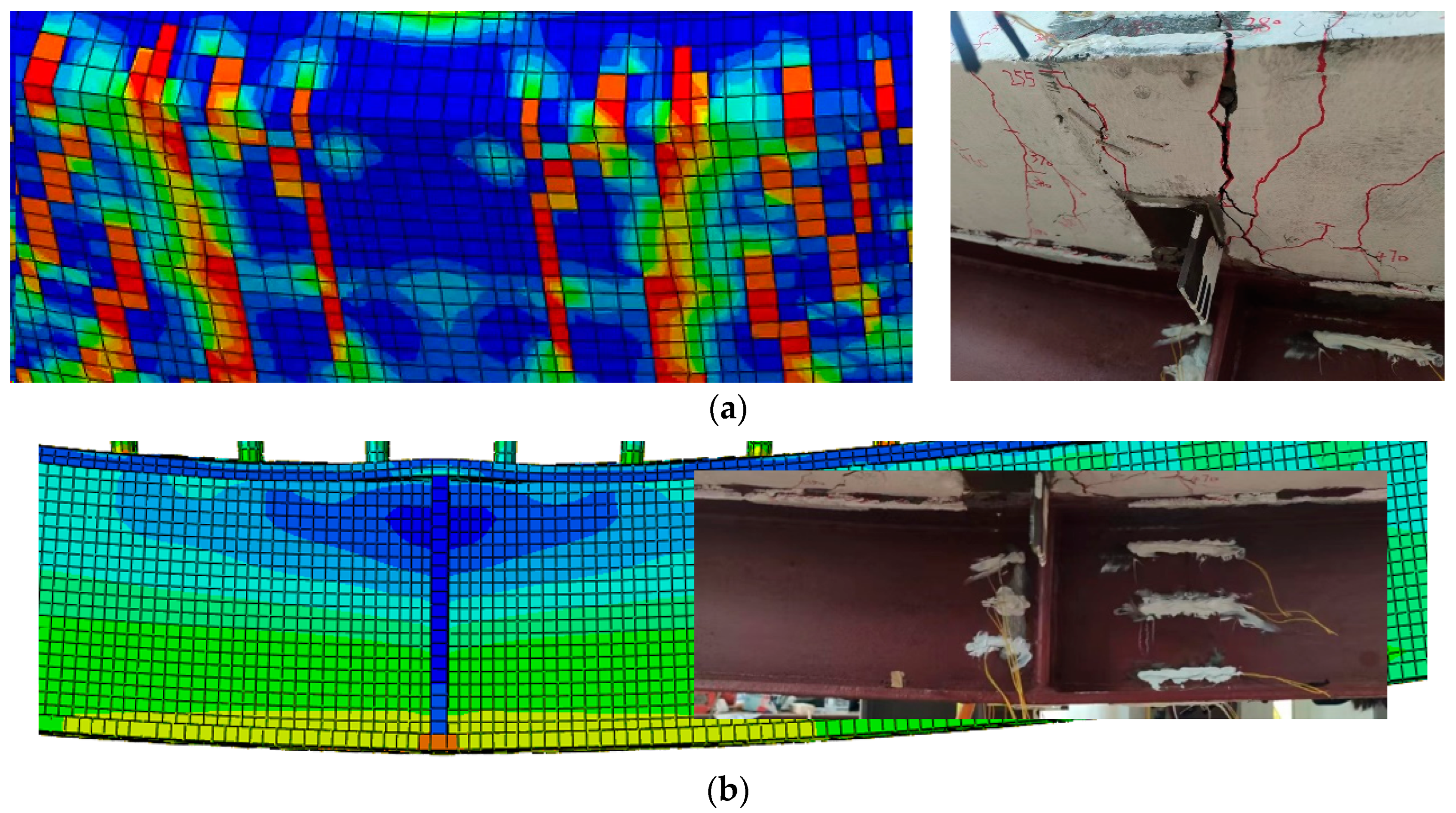
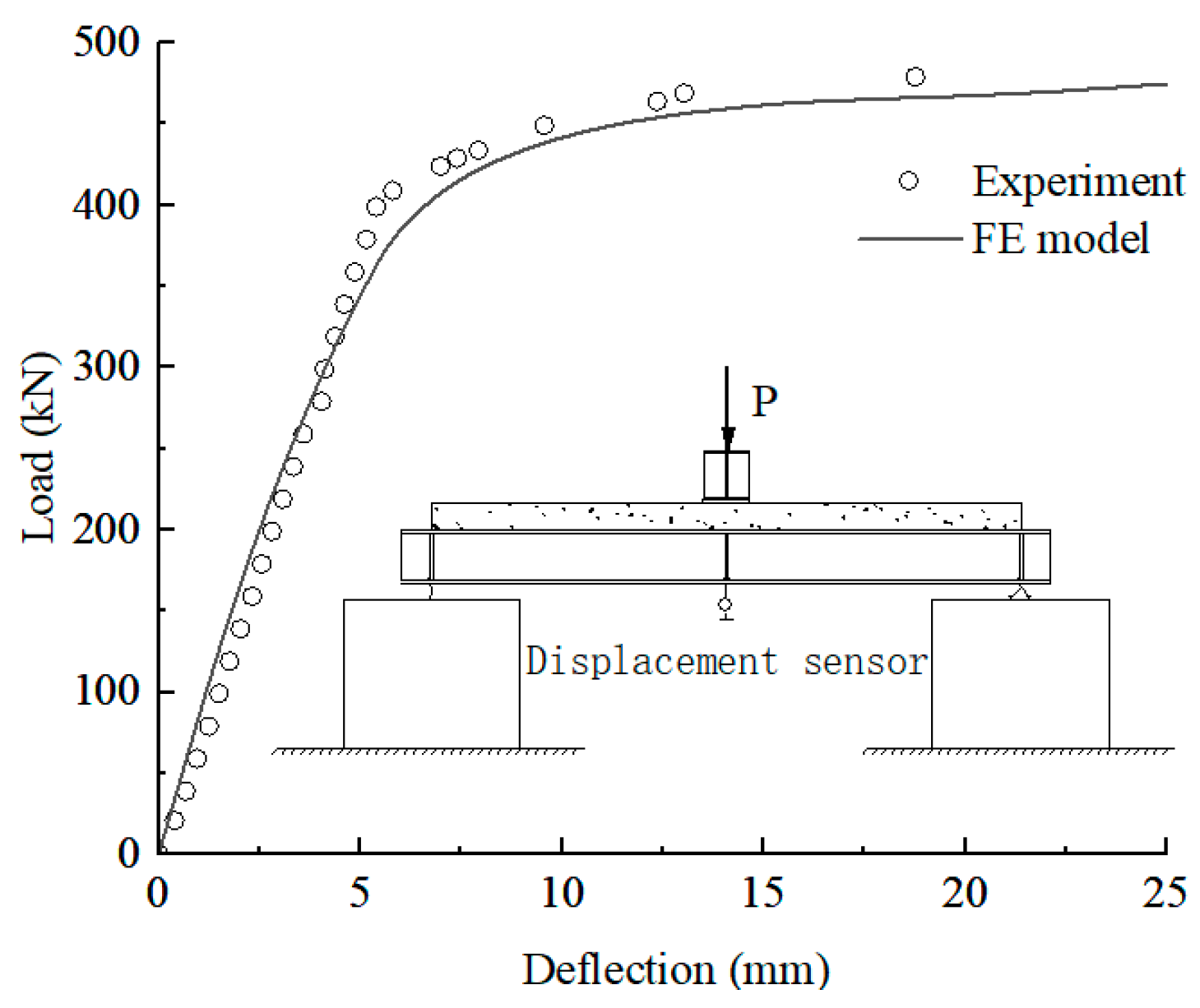
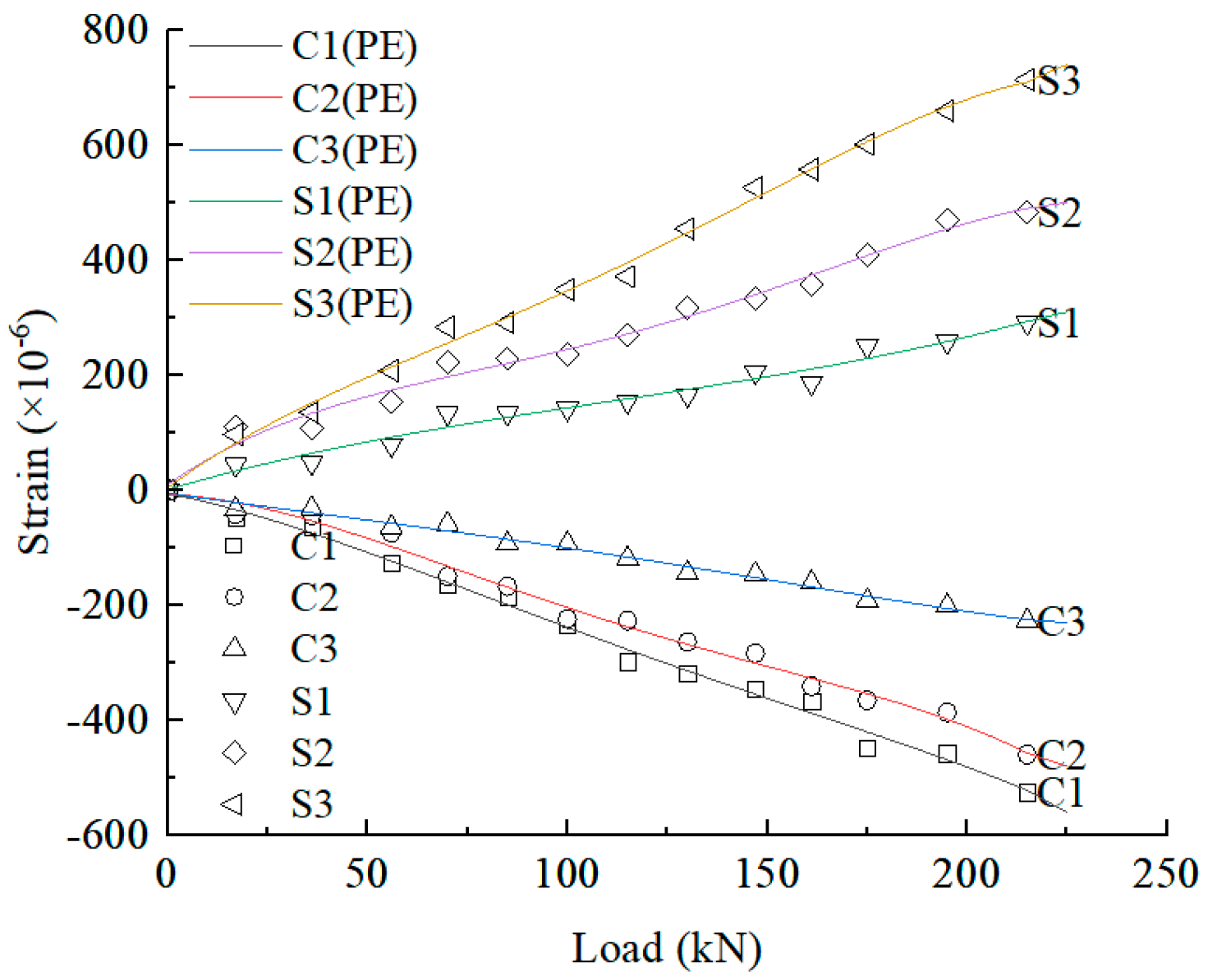





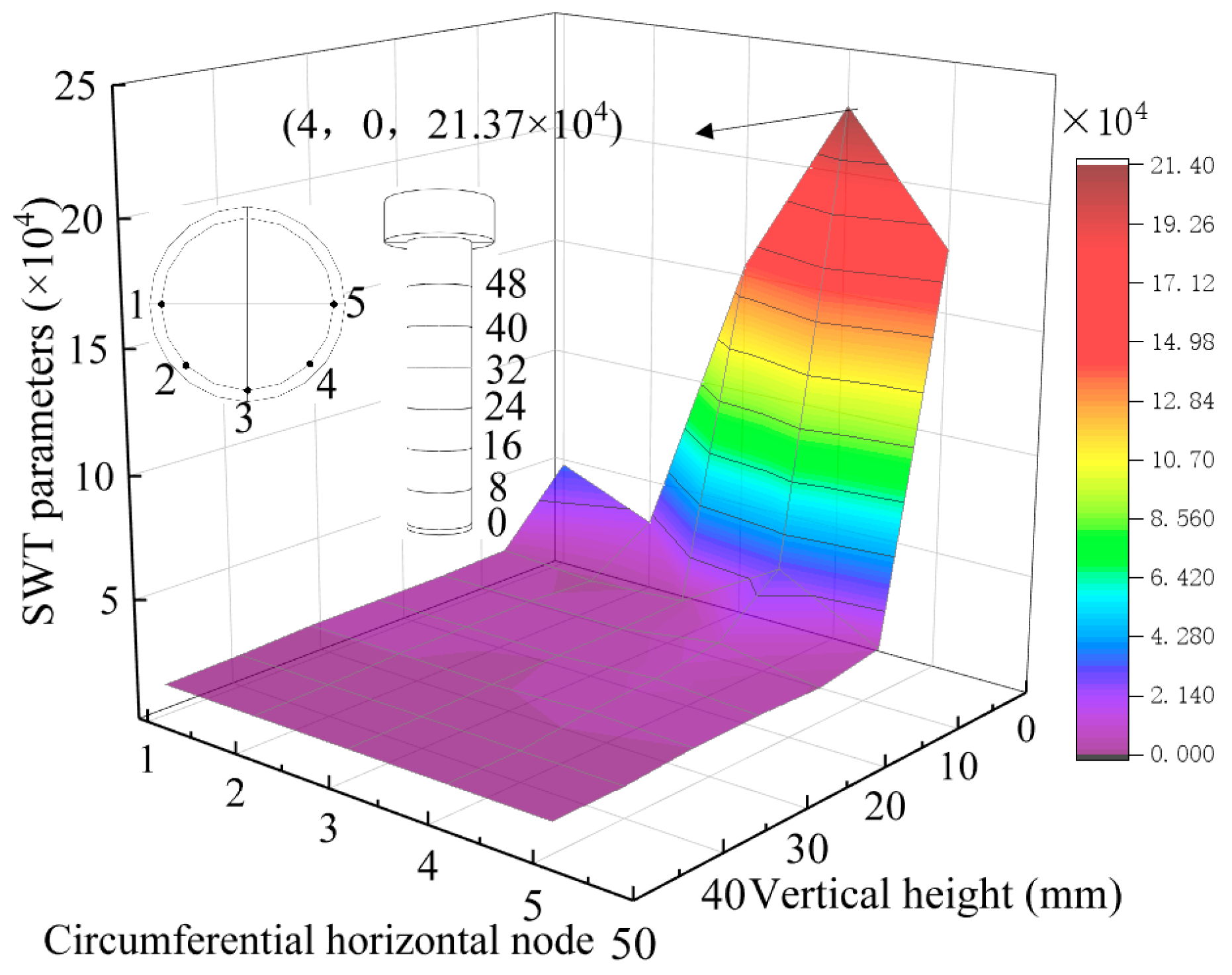
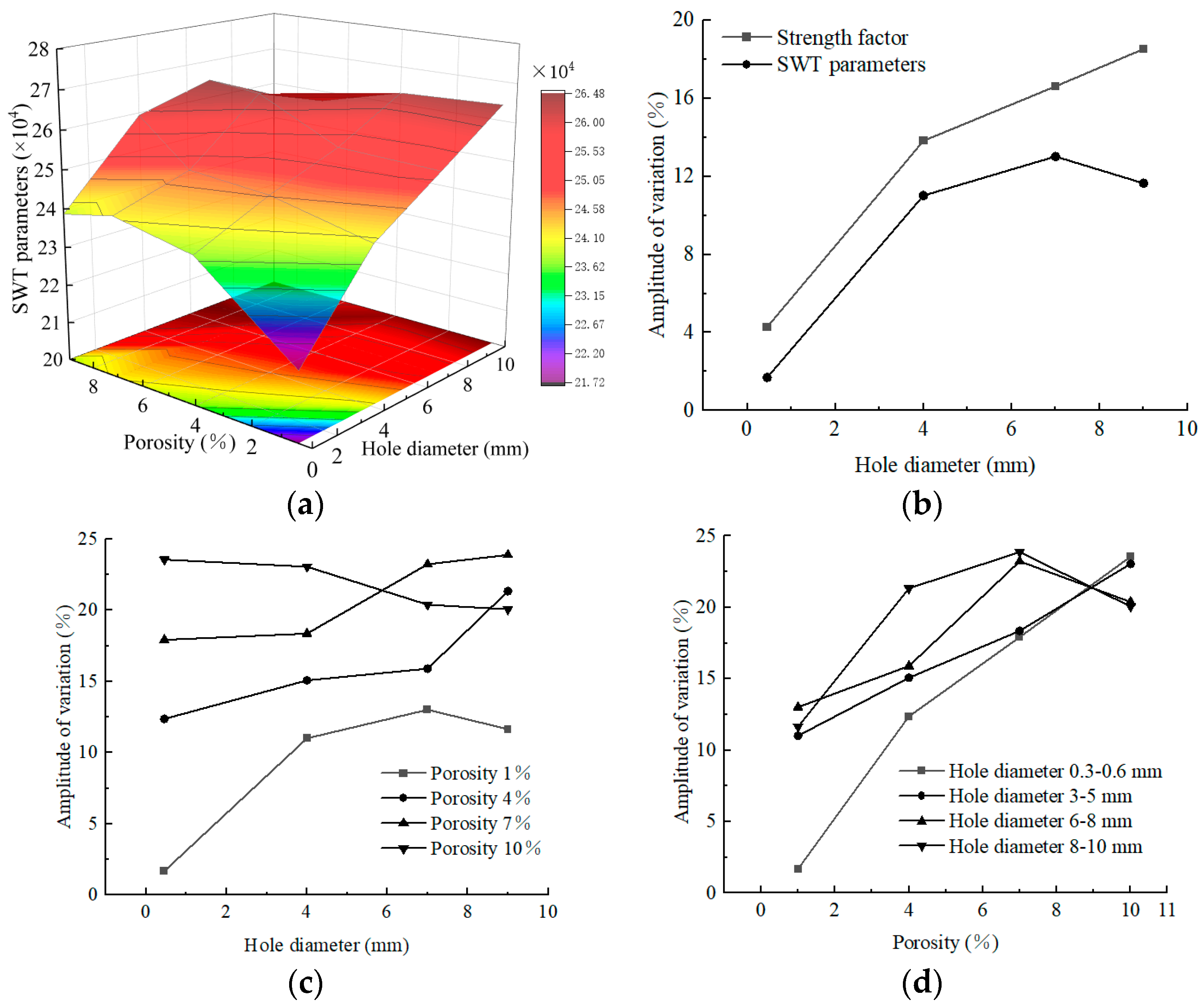
| Component | Material | Size Settings (mm) |
|---|---|---|
| Longitudinal rebar | HPB300 | 8@108 |
| Transverse rebar | HPB300 | 6@100 |
| Steel plate | Q235 | 2200 × 160 × 10 |
| Concrete slab | C40 | 2000 × 600 × 100 |
| Stud connectors | ML-15 | 13@80 |
| Material | fy (MPa) | fu (MPa) | εy | εu |
|---|---|---|---|---|
| ML-15 | 440 | 528 | 0.002 | 0.044 |
| Q235 | 345 | 450 | 0.002 | 0.052 |
| Parameter | Expansion Angle (°) | Eccentricity (%) | fb0/fc0 | K | Viscosity Parameter |
|---|---|---|---|---|---|
| Value | 35 | 0.1 | 1.16 | 2/3 | 0.005 |
| Porosity (%) | Specimen Number | Aperture (mm) | fckn/fck | Ecn/Ec |
|---|---|---|---|---|
| 1 | K1-0.3 | 0.3–0.6 | 0.957 | 0.962 |
| K1-3 | 3–5 | 0.868 | 0.959 | |
| K1-5 | 6–8 | 0.834 | 0.945 | |
| K1-8 | 8–10 | 0.815 | 0.924 | |
| 4 | K4-0.3 | 0.3–0.6 | 0.892 | 0.942 |
| K4-3 | 3–5 | 0.781 | 0.920 | |
| K4-5 | 6–8 | 0.770 | 0.901 | |
| K4-8 | 8–10 | 0.764 | 0.888 | |
| 7 | K7-0.3 | 0.3–0.6 | 0.7955 | 0.878 |
| K7-3 | 3–5 | 0.675 | 0.839 | |
| K7-5 | 6–8 | 0.651 | 0.801 | |
| K7-8 | 8–10 | 0.639 | 0.776 | |
| 10 | K10-0.3 | 0.3–0.6 | 0.698 | 0.809 |
| K10-3 | 3–5 | 0.587 | 0.776 | |
| K10-5 | 6–8 | 0.571 | 0.761 | |
| K10-8 | 8–10 | 0.564 | 0.748 |
Disclaimer/Publisher’s Note: The statements, opinions and data contained in all publications are solely those of the individual author(s) and contributor(s) and not of MDPI and/or the editor(s). MDPI and/or the editor(s) disclaim responsibility for any injury to people or property resulting from any ideas, methods, instructions or products referred to in the content. |
© 2024 by the authors. Licensee MDPI, Basel, Switzerland. This article is an open access article distributed under the terms and conditions of the Creative Commons Attribution (CC BY) license (https://creativecommons.org/licenses/by/4.0/).
Share and Cite
Wang, D.; Li, N.; Tan, B.; Shi, J.; Zhang, Z. Multiaxial Fatigue Damage Analysis of Steel–Concrete Composite Beam Based on the Smith–Watson–Topper Parameter. Buildings 2024, 14, 1601. https://doi.org/10.3390/buildings14061601
Wang D, Li N, Tan B, Shi J, Zhang Z. Multiaxial Fatigue Damage Analysis of Steel–Concrete Composite Beam Based on the Smith–Watson–Topper Parameter. Buildings. 2024; 14(6):1601. https://doi.org/10.3390/buildings14061601
Chicago/Turabian StyleWang, Da, Nanchuan Li, Benkun Tan, Jialin Shi, and Zhi Zhang. 2024. "Multiaxial Fatigue Damage Analysis of Steel–Concrete Composite Beam Based on the Smith–Watson–Topper Parameter" Buildings 14, no. 6: 1601. https://doi.org/10.3390/buildings14061601





